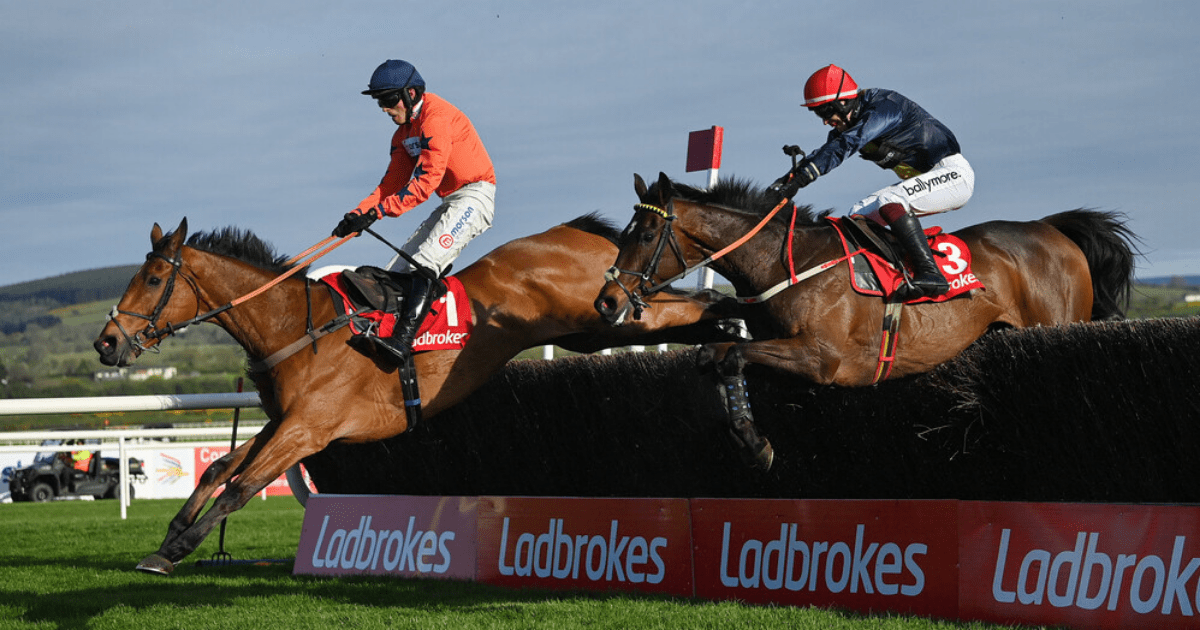GALOPIN DES CHAMPS charges to victory at the Irish Gold Cup at Leopardstown.
Four horses battle it out for the big prize, and we've got you covered with all the finishing places below.
Finishing Order
1 Galopin Des Champs 1/3
Full finishing order to follow…
Templegate's tips for Leopardstown
4.10
MADARA had solid form in France and ran right up to his best when scoring over a similar trip at Cheltenham last time.
He jumped well in beating a useful field and a 3lb rise in the weights looks more than fair.
The Folkes Tiara enjoyed himself when winning here last time and kept up the gallop well after hitting the front a long way out. He should be competitive again.
Solness enjoyed dropping into handicap company when scoring by six lengths at Fairyhouse. A 9lb rise in the weights means he'll have to find more.
Path D'Oroux was a solid second last time but is creeping up the handicap so needs to improve.
4.40
A DREAM TO SHARE has yet to put a foot wrong, winning the Champion Bumpers at Cheltenham and Punchestown.
The only worry is the reportedly minor injury that means he's back in a bumper rather than going over hurdles.
His best form would make him a long odds-on shot and he should be good enough even if not wound up.
Frequently Asked Questions
How important is the pedigree of a racehorse for success?
While pedigree can be an indicator of potential, it is not the sole determinant of a racehorse’s success. A horse’s lineage may suggest an inherited aptitude for speed or endurance, but training, health, and temperament are also influential factors. A horse’s natural ability can be maximized by good training, and it may even outperform horses with impressive pedigrees.
What health precautions must be taken when training racehorses?
Meticulous attention to a racehorse’s health is vital in preventing injury and illness. Regular veterinary visits, vaccinations, dental care, and good hoof care are all essential. Monitoring the horse’s signs of fatigue, discomfort or strain is equally important. A well-planned training program that allows for a gradual increase in intensity will help reduce the risk of musculoskeletal injury.
What diet is the most suitable for a horse that races?
Racehorses need a diet that is high quality and perfectly balanced to support their training and racing. The diet is usually a mixture of high-quality hay, grains like oats and barley, as well as commercially prepared racehorse feed. In addition, essential vitamins should be added to the diet in order to maintain peak performance and overall health.
Is it necessary for a racehorse to have a specific type of shoe?
Racing plates are typically lighter and thinner compared to regular horseshoes. These plates minimize weight while providing the necessary traction for the racetrack. A racehorse-trained farrier will fit and select the right shoes for each horse based on its hoof shape and the racing surface.
What is the role a jockey plays in the training and preparation of racehorses?
Jockeys have a crucial role to play in the training of racehorses. The jockeys ride the horses, giving feedback on their performance. They also help to educate the horse in racing tactics, like pacing the horse, positioning it, and responding when given commands. A good jockey is able to recognize the horse’s strengths, weaknesses and how they can be improved.
How can you ensure the mental wellbeing of your racehorse?
Maintenance of a racehorse’s mental health is as crucial as its physical conditioning. Diverse routines are important for a racehorse’s mental well-being. To prevent stress, it is important that the horse be socialized and has a stable and calm environment.
Statistics
- Studies suggest that proper early training can reduce the risk of musculoskeletal injuries in racehorses by up to 50%.
- Statistically, less than 1% of thoroughbred foals born each year will go on to win a stakes race.
- Around 80% of thoroughbred racehorses begin their racing careers by the age of two, according to industry estimates.
- Gastrointestinal issues affect up to 90% of racehorses during their training, emphasizing the need for careful dietary management.
- Racehorse mortality rates during racing have been observed to be between 1.5 to 2 deaths per thousand starts, depending on the racing jurisdiction.
- The average cost to train a thoroughbred racehorse for one year can exceed $50,000, accounting for expenses related to training, boarding, and veterinary care.
External Links
keeneland.com
jockeyclub.com
equibase.com
thoroughbredracing.com
britishhorseracing.com
bloodhorse.com
How To
How To Reduce Injury Risks When Training Racehorses
Implementing a training program that matches the horse’s current fitness level will help to minimize injury risks. To avoid overtraining, combine high-intensity work with ample recovery time. For safety, make sure the surfaces of racing and training are kept in good condition. Check for wear and tear and use the correct fitting tack. Cross-train using swimming or low-impact sports to balance joint and muscle health.

